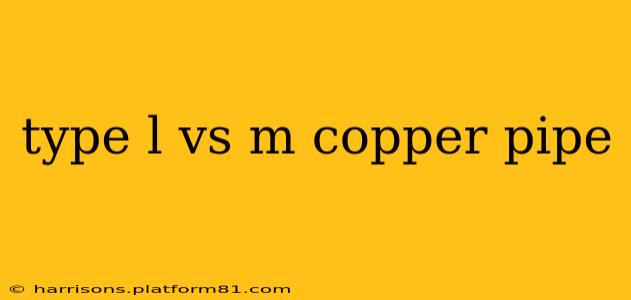Choosing the right type of copper pipe for your plumbing project is crucial for ensuring longevity, durability, and safety. While both Type L and Type M copper pipes are widely used, understanding their key differences is essential for making an informed decision. This guide delves into the specifics of Type L and Type M copper pipes, helping you determine which is best suited for your needs.
What are Type L and Type M Copper Pipes?
Both Type L and Type M copper pipes are made from copper, a highly durable and corrosion-resistant material ideal for plumbing applications. The key difference lies in their wall thickness: Type L has a thicker wall than Type M. This seemingly small difference significantly impacts their pressure ratings and applications.
-
Type L Copper Pipe: This is the thickest and strongest type of copper pipe commonly available. Its robust construction allows it to withstand higher water pressures, making it suitable for demanding applications.
-
Type M Copper Pipe: Type M copper pipe possesses a thinner wall than Type L, resulting in a lighter weight and lower cost. While still durable, it's designed for applications with lower pressure requirements.
Type L vs. M Copper Pipe: Key Differences Summarized
| Feature | Type L Copper Pipe | Type M Copper Pipe |
|---|---|---|
| Wall Thickness | Thickest | Thinner |
| Pressure Rating | Higher | Lower |
| Weight | Heavier | Lighter |
| Cost | More expensive | Less expensive |
| Applications | High-pressure systems, underground use | Low-pressure systems, above-ground use |
| Durability | Excellent, resists high pressure | Excellent, suitable for normal pressure |
What are the typical applications for Type L and Type M copper pipes?
Type L Copper Pipe Applications:
Type L's superior strength makes it ideal for:
- High-pressure applications: Systems requiring higher water pressures, such as those in high-rise buildings or areas with significant water pressure fluctuations.
- Underground installations: The thicker walls offer better protection against external forces and potential damage during installation.
- Applications requiring extra durability: Situations where the pipe might experience significant stress or potential damage.
Type M Copper Pipe Applications:
Type M is a cost-effective choice for:
- Low-pressure systems: Residential applications, where water pressure is typically lower, are well-suited to Type M.
- Above-ground installations: Its lighter weight makes it easier to handle and install in above-ground applications.
- Interior plumbing: Most household plumbing systems are designed to operate within the pressure limits of Type M copper pipe.
Which type of copper pipe is right for my project?
The best choice depends entirely on your specific needs and project requirements. Consider these factors:
- Water pressure: High-pressure systems require Type L; lower-pressure systems can generally utilize Type M.
- Installation location: Underground installations necessitate the durability of Type L, while above-ground applications can often employ Type M.
- Budget: Type M is a more budget-friendly option compared to Type L.
What is the difference in cost between Type L and Type M copper pipes?
Type M copper pipe is generally less expensive than Type L due to its thinner wall and consequently, less material. The price difference can vary depending on the supplier and market conditions, but expect Type L to be more costly per foot.
Can I use Type M copper pipe where Type L is specified?
No. Using a thinner-walled pipe (Type M) where a thicker-walled pipe (Type L) is required compromises the system's integrity and may lead to leaks or failures under pressure. Always adhere to the specifications outlined in your project plans and local plumbing codes.
What are the advantages and disadvantages of each type?
Type L Advantages: Higher pressure rating, superior durability, suitable for demanding applications.
Type L Disadvantages: Higher cost, heavier weight.
Type M Advantages: Lower cost, lighter weight, suitable for most residential applications.
Type M Disadvantages: Lower pressure rating, may not be suitable for all applications.
By carefully considering these factors, you can choose the appropriate copper pipe to ensure a safe, reliable, and long-lasting plumbing system. Consulting with a qualified plumber is always recommended for complex or high-pressure applications to guarantee compliance with local codes and best practices.
